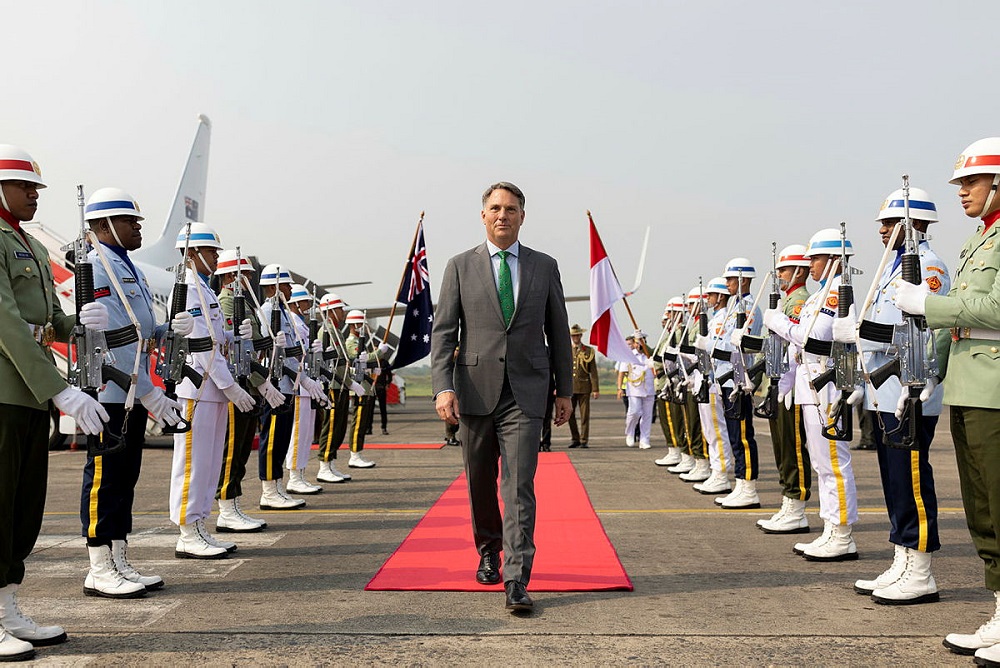
‘Strategy without money is just hot air.’
— Deputy Prime Minister and Defence Minister Richard Marles speaking at ASPI’s 2023 conference, 14 September, Canberra
At ASPI’s national conference, the deputy PM and defence minister was doing ‘d’ alliteration—disruption, deterrence and dollars.
The Richard Marles line on dollars channels a famous Canberra creed, uttered in sharp and grumpy tones by the man who created the modern defence department, Arthur Tange: ‘Until you’re talking dollars, you’re not talking defence.’
The minister’s view of ‘hot air’ is an important policy balloon that translates as a Labor target. Track the dollars in the days to come to measure the actual power of the policy.
The last time Labor was in government, especially under Julia Gillard, it looted the defence budget for other purposes (including getting Australia through the 2008–09 global financial crisis). While not referencing that history, Marles painted a picture of a different Labor government dedicated to lifting defence spending.
The change reflects darkly different times.
A decade ago, the Gillard government built policy on a happy vision of the bounties flowing from the ‘Asian century’. Today, Marles describes a threatening Indo-Pacific where deterrence and defence must be linked to the hopes of diplomacy: ‘If we want to maintain peace and stability, then getting the hard-power equation right is a critical component of that. And certainly that’s how we think about it in terms of our own strategic landscape now, which is very complex and not a little threatening.’
Marles’s description of the way the world has changed is also a description of what’s changed in Labor’s worldview.
Australia’s budget history since federation, he said, reflected a ‘binary sense of war and peace’. In peace, defence spending went down; in war it jumps. ‘I don’t think that’s the world we’re in now. I think the grey zone is much bigger.’ The end of the binary divide, Marles said, meant old norms no longer applied.
On the budget, Marles is talking future dollars some years out, because the projection in the May budget didn’t reflect the urgency of the demands on defence. ASPI’s 2023–24 defence budget brief called it ‘the big squeeze’. The only increase over the next three years is compensation for the increased cost of imported military equipment flowing from a fall in the value of the Australian dollar.
Marles said Labor was working with the three-year forward estimates bequeathed by the previous Coalition government:
In a rational world, defence spending is a function of strategic threat. And we aspire to be a rational government, and that’s why you’re seeing an increase in defence spending. What we inherited when we came to government was an increase. That increase is maintained through the forwards. And so we actually went to the election saying we would commit to precisely the same funding the former government had established and that’s what we are doing over the forward estimates.
Taking that as Labor’s starting point, a key measure of the difference between hard strategy and hot air will be how the spending line keeps rising. And that’s where the government’s promise to lift defence spending to 2.3% of GDP over a decade becomes the target to monitor, as Marles explained:
We’ll stay on the same pathway of increase over the next four years. Through the next 10 we’re going to increase the trajectory. So, to put numbers on that, basically defence spending was somewhere below 2% [of GDP]; it’s about 2% now under the trajectory that we inherited from the former government with their 2.1% within a decade.
We are taking 2.3% because of the strategic threat that we perceive. I guess the question then, given the strategic threat, if you seek to be rational, is 2.3% the right answer? We think it is.
As the defence minister mused, 2.3% of GDP is a response to what Australia sees before it. If the view changes, the dollar ambition will have to change too:
I don’t sit here thinking that we are on the eve of conflict. I sit here thinking that we are in the midst of uncertainty, that predicting the next 10 years is very difficult.
I can completely imagine a peaceful trajectory over the next decade and beyond. I think that’s entirely in the realm of possibility and that’s obviously what we should all be seeking. The difficulty is I can imagine something else and it’s the uncertainty of that which gives rise to the fact that we are seeing an upswing in our defence spending.
In questions, ASPI’s Jennifer Parker pushed Marles on the dollars, pointing out that the defence funding profile still rests on a frame going back to the 2016 defence white paper. Much had changed. Had the time come to rethink the funding profile?
‘Strategy without money is just hot air,’ Marles replied. ‘We’re talking about a 10% increase on what was intended to be committed just 17 months ago, over the course of the next decade. Instead of 2.1%—2.3% of GDP. That is a very significant step. And it is a very significant step in historic terms.’
The final question was about the content of the classified version of the defence strategic review and a new focus on how Australia needs to plan to mobilise businesses and the private sector for defence purposes.
Marles said the full version of the review discusses mobilisation: ‘It’s really the first discussion of that kind of issue in a defence document—a document that Defence has embraced—probably since the end of the Second World War. It’s a hugely significant analysis.’
Australia is already digesting the reality of a lot more money for defence. The emerging questions centre on the nation’s risk appetite in uncertain times to deliver deterrence. And what would ‘mobilisation for defence purposes’ mean for Australia? Even if you don’t see all that as a great disruption, it’s certainly different. And it is delivering a different Labor government.

